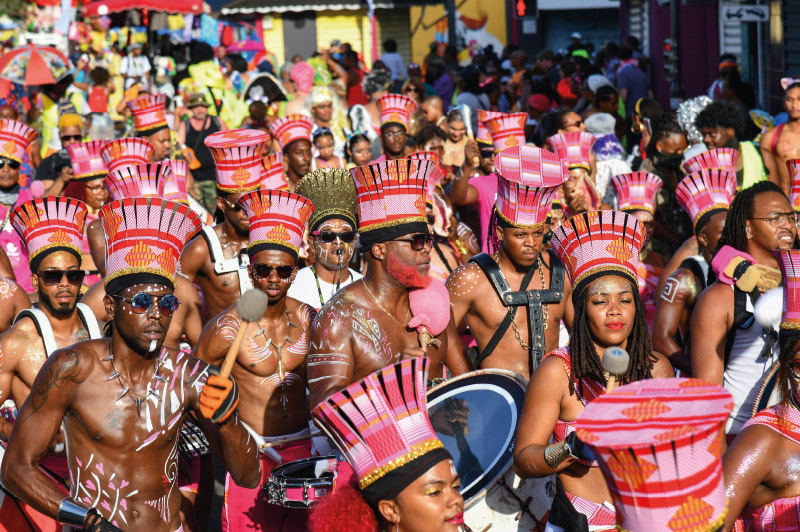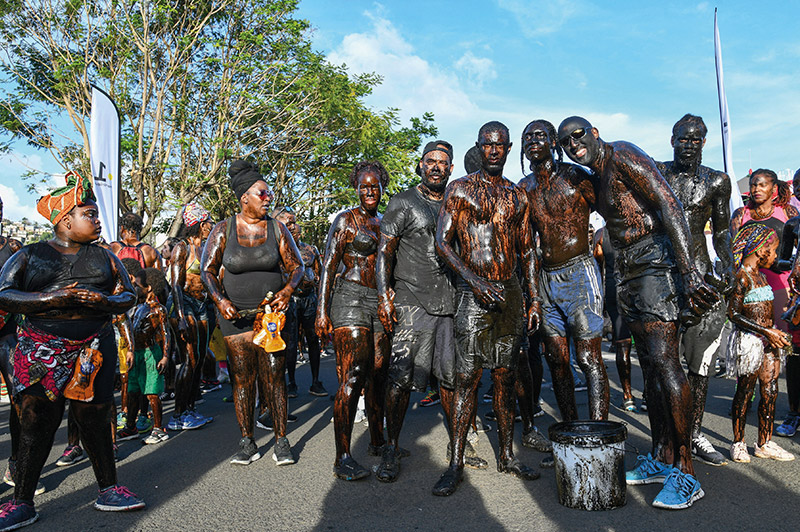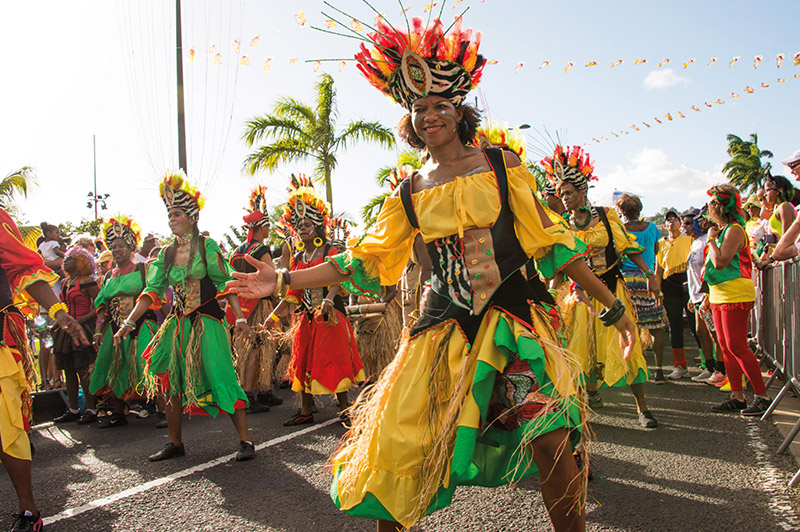
The highly anticipated Carnival in Martinique takes place on February 18-22, 2023. Five days of jubilation during which time locals and visitors can party, dance, sing, and reinvent themselves in total liberty. For those not yet familiar with the specifics of Carnival on the “flower island” of the Caribbean, here is a stroll through Shrovetide and Fat Tuesday, and the typical, well-entrenched characters.
Modern and continually renewing itself, while deeply anchored in the history of multiple cultures, Carnival in Martinique is one of a kind. Born in the 18th century, during the period of slavery, its origins are found in celebrations of the past. Linking diverse and mixed populations, this celebration unites people whose cultures share common denominators. Dancing to wild music, the fête served as a release, a way to get back to one’s roots, to denounce with mockery the injustices and other sources of daily miscontent. Today, Carnival still provides an opportunity for satire based on current events or public figures. But it is above all a moment of conviviality, of togetherness, and collective joy as well as creativity. Contrary to the highly codified Carnival in Brazil, the one in Martinique gives free rein to the participants to spontaneously be who they want, how they want, without any rules or constraints. The result is a parade in the streets with all kinds of costumes: sophisticated, custom-made, improvised, and even minimalist… And every day during Carnival has its special ambiance or specific theme.

2. Mariage burlesque. Crédit photos : ©G.Germain
SHROVE SUNDAY, THE KICKOFF ~ While aficionados start attending costume parties several weeks before Carnival, its official debut is the first Sunday after Epiphany. Shrove Sunday is a spectacular and sparkling occasion. The Queen of Carnival makes her appearance. Marching groups are out and about, adorned in bright costumes, dancing to the most popular music or to newly minted songs. They set the tempo and beat the pavement as they invite crowds to follow along.
Street orchestras are also part of the scene, followed by revelers who sing, jump, and dance to the music of percussionists and the blowing of conch shells. This is the day of the big parade. Music can be heard wherever you go, including the “bradjaks,” or old cars all decked out for the occasion and known for their critical slogans about the “system.” Shrove Sunday is also the first appearance of the men in clay, who are literally covered with it and remain stationary in the middle of the street, like statues, or forming tableaux together. Amazing!
You might also come across the “Nèg Gwo Siwo,” men who cover their entire bodies with sugarcane molasses in homage to former fugitive slaves, the Nèg’ Marrons. Plastered in this black, viscous liquid, they have fun trying to get close to people passing by who run away from them laughing or shrieking in fear of being stained with the gooey substance. But the most highly anticipated moment of Shrove Sunday is his majesty, Vaval, the Carnival King. Every year, this gigantesque effigy created by local artists is a faithful, allegoric, or symbolic representation of a hot subject from the past year or a major personality. Vaval marks the opening as well as the close of Carnival, as we shall see… so let’s keep walking…

SHROVE MONDAY: FROM PAJAMAS TO A WEDDING DRESS~ At dawn, a “vidé,” or a parade in the streets to the sound of drums, unites the early risers with the late-night revelers who are just heading home from parties. The pajamas, are, of course, the signature clothing for the parade. Nightshirts as well, even worn by men, in the traditional inversion of genders that also characterizes the Carnival in Martinique. This “vidé” at dawn is often followed by a convivial moment when friends and neighbors share Creole boudins and “Tinain-lan mori” (bananas boiled with dried codfish), a dish once eaten by agricultural workers and now appreciated by everyone, and which helps replenish your energy. Ideal in anticipation of the “vidé” in the afternoon. A few hours of rest and it all starts up again. At the heart of Shrove Monday is the burlesque marriage, where the woman is the groom—often wearing a jacket with a moustache drawn or glued on her face—and the man is the bride, in a white lace dress or simple white undergarments symbolic of a honeymoon: On Shrove Monday, the “vidé” is the high point of the fête!
MARDI GRAS: RED DEVILS ON PARADE~ On Mardi Gras, a red tide floods the streets. Everyone is dressed in the color of the red devils who set the tone with their bright red coats covered with mirrors and adorned with a cow’s tail. They wear scary masks with mirrors that symbolize knowledge and bovine horns that signify abundance. For centuries that have led a festive reign of terror, having fun trying to scare kids and adults. On Mardi Gras, or Fat Tuesday, street orchestras, marching groups, and floats with sound systems lead the crowd in a frenzied cavalcade.

ASH WEDNESDAY: ADIEU TO THE KING~ On Ash Wednesday, the death-knell of Carnival tolls. Everyone comes to pay their respects to the king Vaval. The goddesses—part of an ancient popular myth—celebrate one last time before it’s time for tears. Thousands of Carnival revelers and spectators fill with streets with their black and white costumes. They keep singing the same song in Creole: “Magré lavi-a red, Vaval ka kité nou! (despite the harshness of life, Vaval is going to leave us). Women, and Vaval’s mistresses—generally men dressed as women—dissolve in tears and cry even more later in the evening when Vaval is burned. But what better than a fête to drown your sorrows: and this party lasts until the wee hours. A festive way to start the grieving that lasts a year, the head full of souvenirs and already impatient for the next Carnival.
Auteur Agnès Monlouis-Félicité
MORE INFORMATION
How to make reservations to stay in Martinique:
https://www.martinique.org
More about the Carnaval in Martinique:
https://www.martinique.org/carnaval

